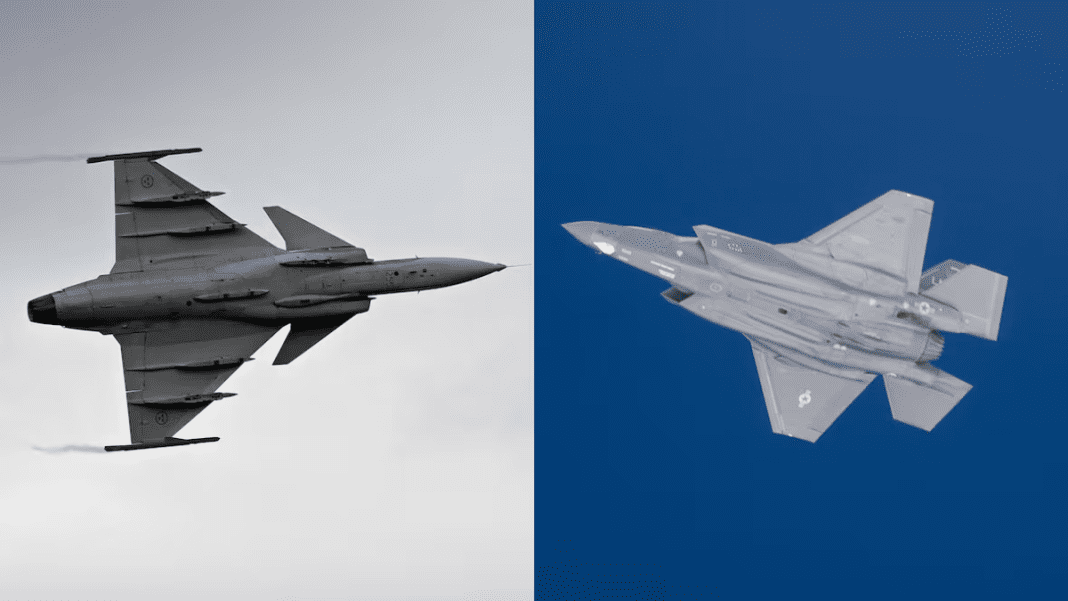Newly released internal data has shed light on Canada’s search for its next-generation fighter jet. The documents reveal that the Lockheed Martin F-35A Lightning II clearly outperformed Saab’s Gripen E across every major category in the country’s latest fighter evaluation. The gap is so significant that it has sparked new debates about Canada’s fighter procurement decisions.
F-35 Outshines Gripen Across Every Measure in Fighter Evaluation
Canada launched the Future Fighter Capability Project (FFCP) to replace its aging CF-18 jets, aiming to find a fighter capable of meeting modern defense needs. The evaluation, conducted in 2021, involved a detailed scoring system covering mission performance, technical features, upgradability, sustainment, and overall capability delivery.
According to the newly released data from the fighter evaluation, the F-35 scored an impressive 57.1 out of 60 points, which translates to 95%. The Gripen E, on the other hand, scored just 19.8 points, or 33%. While both aircraft met the mandatory requirements, the F-35’s superior operational capabilities made a decisive difference once the full scoring criteria were applied.
Saudi-U.S. F-35 pact rattled by revelations of stealth downgrade and tech removal
Breaking down the results shows the scale of the difference: in mission performance, the F-35 scored 97%, nearly five times higher than the Gripen’s 22%. The F-35 also achieved 100% in upgradability, while the Gripen managed only 28%. Even in sustainment, where the Gripen performed best, it still fell short of the F-35, earning 81% compared to 85%. Technical criteria and overall capability delivery further highlighted the F-35’s advantage, leaving the Gripen far behind in all areas.
The numbers from the fighter evaluation are striking, showing that the F-35 consistently outperformed its competitor in key categories that determine how well a fighter can operate in modern combat situations.
Industrial and Political Considerations Still in Play
Despite the clear performance gap revealed by the fighter evaluation, the Gripen E has not been completely dismissed. Saab continues to promote the aircraft to Canadian officials, highlighting advantages such as lower operating costs, faster maintenance, and the ability to disperse quickly. The company also emphasizes opportunities for Canadian industry, including the potential for local assembly in partnership with Bombardier.
Erdogan Hails ‘New Era’ with Trump: Halkbank Sanctions Near End, F-35 Deal Resurfaces
These industrial benefits have become more significant as Canada reconsiders the balance between operational capability and domestic economic involvement. Saab is reportedly in discussions with Bombardier for a possible joint production arrangement, suggesting that industrial returns remain a key factor in Ottawa’s ongoing review of fighter options.
However, with the new data from the fighter evaluation showing such a large performance gap, any push for the Gripen or a mixed fleet will face tough scrutiny. The public release of the fighter evaluation scores is likely to intensify pressure on Canadian officials to clearly explain how they plan to weigh industrial considerations against operational effectiveness.
Official Scores Highlight F-35’s Strength in Fighter Evaluation
The official scoring table released by Radio-Canada provides a detailed look at how each fighter performed in the fighter evaluation:
Category Weight F-35 Score (%) Gripen Score (%) Mission Performance 52% 97 22 Upgradability 28% 100 28 Sustainment 11% 85 81 Technical Criteria 6% 86 55 Capability Delivery 2% 67 54
These numbers make one fact clear: in every major measure of fighter capability, the F-35 came out on top. The dominance is particularly stark in mission performance and upgradability, two categories critical for a modern air force that needs to operate in complex combat environments.
F-35 gets deadlier — U.S. arms Nordic ally with 340 Sidewinder missiles in $318M deal
As the Canadian government reviews its decision to purchase 88 F-35 jets, this new data from the fighter evaluation adds urgency to the discussion. It demonstrates that while cost and industrial participation are important, the operational gap between the F-35 and Gripen is massive. Any decision to diverge from the F-35 program now would need a strong justification.
The release of these evaluation results is reshaping the conversation around Canada’s future fighter fleet. For now, the F-35 stands out as the clear winner, offering unmatched capabilities that are difficult to match by any other contender in the fighter evaluation.
